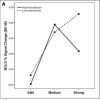Experiential, autonomic, and neural responses during threat anticipation vary as a function of threat intensity and neuroticism
- PMID: 21093595
- PMCID: PMC3031673
- DOI: 10.1016/j.neuroimage.2010.11.040
Experiential, autonomic, and neural responses during threat anticipation vary as a function of threat intensity and neuroticism
Abstract
Anticipatory emotional responses play a crucial role in preparing individuals for impending challenges. They do this by triggering a coordinated set of changes in behavioral, autonomic, and neural response systems. In the present study, we examined the biobehavioral impact of varying levels of anticipatory anxiety, using a shock anticipation task in which unpredictable electric shocks were threatened and delivered to the wrist at variable intervals and intensities (safe, medium, strong). This permitted investigation of a dynamic range of anticipatory anxiety responses. In two studies, 95 and 51 healthy female participants, respectively, underwent this shock anticipation task while providing continuous ratings of anxiety experience and electrodermal responding (Study 1) and during fMRI BOLD neuroimaging (Study 2). Results indicated a step-wise pattern of responding in anxiety experience and electrodermal responses. Several brain regions showed robust responses to shock anticipation relative to safe trials, including the hypothalamus, periaqueductal gray, caudate, precentral gyrus, thalamus, insula, ventrolateral PFC, dorsomedial PFC, and ACC. A subset of these regions demonstrated a linear pattern of increased responding from safe to medium to strong trials, including the bilateral insula, ACC, and inferior frontal gyrus. These responses were modulated by individual differences in neuroticism, such that those high in neuroticism showed exaggerated anxiety experience across the entire task, and reduced brain activation from medium to strong trials in a subset of brain regions. These findings suggest that individual differences in neuroticism may influence sensitivity to anticipatory threat and provide new insights into the mechanism through which neuroticism may confer risk for developing anxiety disorders via dysregulated anticipatory responses.
Copyright © 2010 Elsevier Inc. All rights reserved.
Figures






References
-
- Bandler R, Keay KA, Floyd N, Price J. Central circuits mediating patterned autonomic activity during active vs. passive emotional coping. Brain Res Bull. 2000;53:95–104. - PubMed
-
- Barlow DH. Anxiety and Its Disorders. Second ed. Guilford Press; New York: 2002.
-
- Bienvenu OJ, Stein MB. Personality and anxiety disorders: a review. J Pers Disord. 2003;17:139–151. - PubMed
-
- Bolger N. Coping as a personality process: a prospective study. J Pers Soc Psychol. 1990;59:525–537. - PubMed
-
- Boucsein W. Electrodermal Activity. Plenum; New York: 1992.
Publication types
MeSH terms
Grants and funding
LinkOut - more resources
Full Text Sources
Medical
Miscellaneous

